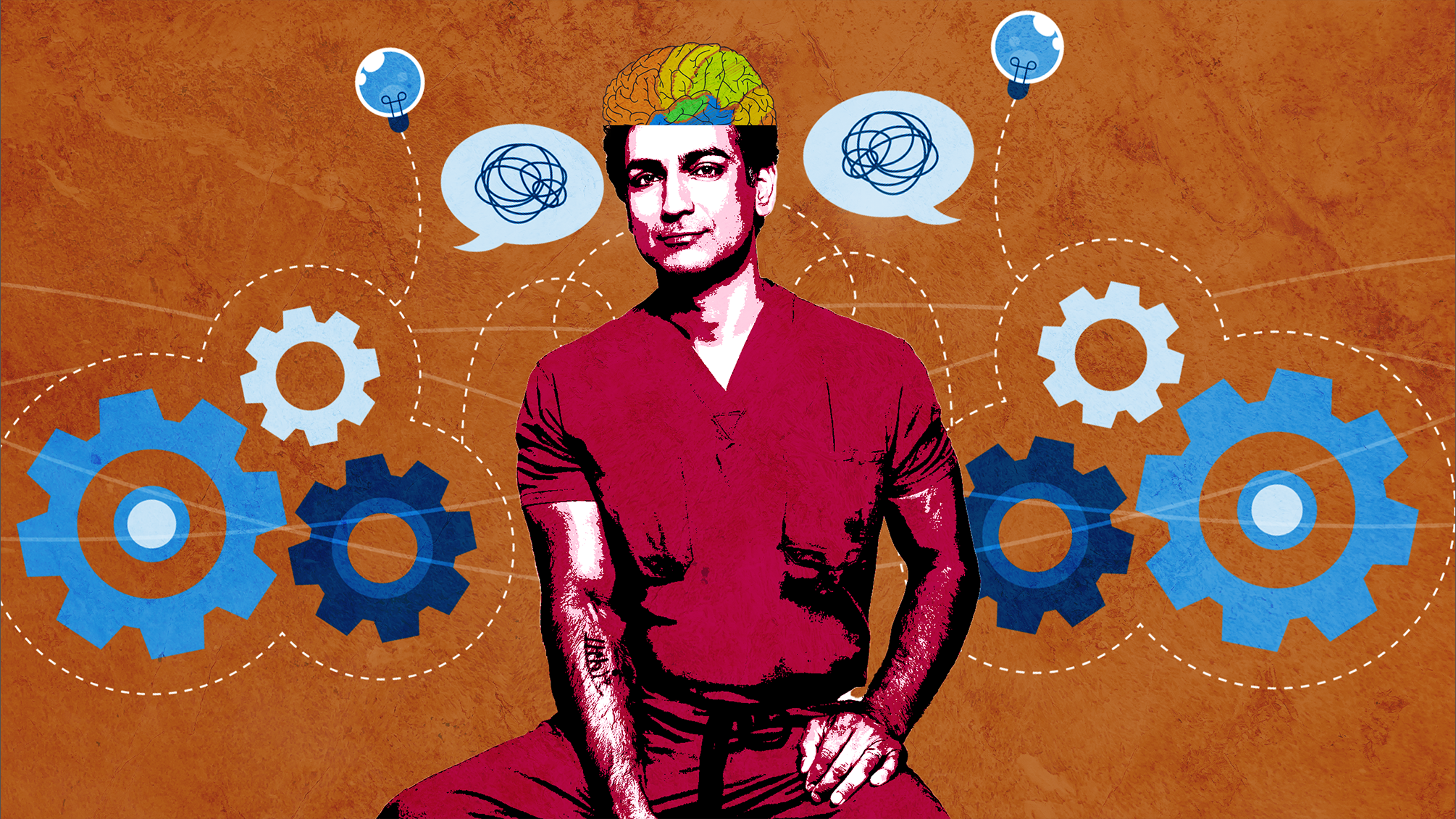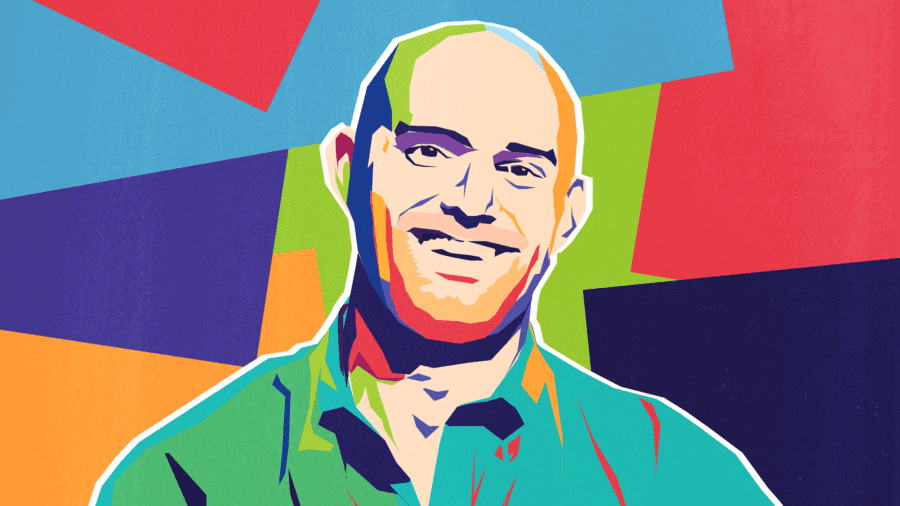
Your Brain Is an Ecosystem: How to Reshape Your Negative Thoughts with Dr. Rahul Jandial
Have you ever wondered why negative thoughts come to mind so frequently?
We program our brains through our habits and thinking patterns, but we are more than capable of changing our brain programming. In fact, our brains evolve constantly, so you’re already equipped to change your thought patterns, habits, and mindset.
On The School of Greatness, we were fortunate enough to feature Dr. Rahul Jandial, MD, Ph.D. Dr. Rahul is a double threat in the field of brain science because he’s both a brain surgeon and a neuroscientist. He works at the City of Hope in Los Angeles, California, and he’s written numerous articles on the brain as well as two books: Life Lessons from a Brain Surgeon and Life on Knife’s Edge: A Brain Surgeon’s Reflections on Life, Loss and Survival.
Dr. Rahul’s research has fascinating implications for our ability to change the way we think. In this article, we share some of his informative insights about our brains, thoughts, and emotions.
Your Brain’s Ability to Change and Overcome Negative Thoughts
A fundamental part of Dr. Rahul Jandial’s research and teaching is that your brain is NOT hardwired, which has enormous implications for our development and how we handle our thoughts and emotions. Dr. Rahul describes the brain as an ecosystem full of hundreds of billions of microscopic jellyfish producing electrical sparks, and each of these microscopic jellyfish is a neuron.
Rather than viewing one’s brain as hardwired and rigid, you can think of it as a constantly-evolving flow, like billions of jellyfish floating in the ocean. In this way, the brain is like an ecosystem that changes daily, and it’s not composed of unmoving wires.
Dr. Rahul noted that the conventional way people think of their brains keeps people stuck. We often think of ourselves as unable to change, but in reality, our brains and thoughts shift constantly. He described our thoughts as being like birds flowing in the sky. There’s a flow to their activity rather than a rigid pattern, and our thoughts and feelings float around in our minds in a similar way. Once you recognize that your thinking constantly evolves, you can begin to reshape your thoughts to serve you better.
You Are NOT the Person You Were Yesterday
Have you ever tried to overcome an unhealthy habit or think more positively but found yourself believing that you can’t change? Often, we believe ourselves to be a certain way — whether negative or positive — and fail to recognize that we’re fully capable of change.
The truth is that you and your brain change EVERY SINGLE DAY, and although change can be challenging, your brain is built for it. How you think and your behaviors are completely malleable because of your brain’s neuroplasticity, meaning its ability to change.
Dr. Rahul went as far as to say that you’re not even the same person as you were a moment ago because your brain has evolved since then. You shift and change from moment to moment.
Although this concept is incredibly encouraging, it’s also important to note that you need to hold on to your positive habits and attributes because you can evolve negatively as well.
Have you ever had a positive habit that you lost over time? Maybe you used to be able to think positively, but now you struggle with defeating negative thoughts. Your brain constantly adapts, so you need to hold on to your positive attributes. If you want to maintain a habit of positive thinking, for example, you might practice positive self-talk or make a habit of writing down what you’re thankful for.
Your brain’s ability to change and adapt is so powerful that people can even lose part of their brain and regain brain functions. Dr. Rahul discussed how some children have undergone surgeries in which medical professionals perform a hemispherectomy, removing half of the brain, to combat epilepsy. Over time, the brain’s remaining half uses its electrical flow to repurpose itself so that the child regains normal brain functions.
The Brain’s Cortex and Limbic System
Let’s take a moment to discuss your brain’s fascinating anatomy. Your brain contains a section in the center called the limbic system, which dictates your behavior and emotions. The outer part of the brain is the cortex, which has to do with reasoning, decision-making, learning, and more.
The cortex and limbic systems have branches that connect one another, and the integration and interaction of the two systems relate to a person’s overall development. Dr. Rahul noted that as a teenager ages, the interaction between their thinking brain — the cortex — and their emotional brain — the limbic system — develops further, resulting in the teenager becoming more thoughtful and reasonable.
Dr. Rahul observed that the healthiest way to regulate one’s emotions is through the interaction between the limbic system and the cortex.
For example, a person may experience joy after their child takes their first steps, and that emotion involves both the limbic system and cortex. Through the cortex, the parent understands the important milestone of a child taking their first steps, so their emotions also involve the thinking brain.
Join In 200 Million+ On The Journey to Greatness
How Neuroplasticity Relates to Emotion Regulation
Although our emotions and thoughts are frequently rooted in particular situations, that’s not always the case. Have you ever found yourself anxious or sad for no particular reason? During those times when you’re experiencing negative thoughts or feelings, you can use tools to help you with emotion regulation.
Emotion regulation refers to one’s ability to have control over their emotions. You don’t want to stifle your emotions, necessarily, but you may want better control over them so that you handle situations appropriately and avoid making mistakes.
For example, you may have a good reason to be upset with someone, but you probably don’t want to yell at them in a public place, so you maintain control over your emotions to convey them more maturely.
Expressing a strong emotion is not always negative, but we often face situations where we need to calm ourselves down to better handle a challenge. Additionally, frequent strong emotions that cause stress can lead to health problems, such as an increased heart rate and blood pressure.
Molding Your Limbic and Cortex Connection
Your emotional regulation skills have everything to do with balancing your limbic system and cortex, and Dr. Rahul describes this concept as regulating “your emotional tone.” You still experience the emotion, but you handle it effectively and logically.
For example, maybe you’re about to meet with your boss and feel incredibly nervous about it. You may find yourself sweating uncontrollably or talking too quickly. You can use emotional regulation tools, like meditative breathing, to calm down and better handle the situation.
Your emotion regulation is malleable, so you can actively improve your ability to handle your emotions and strengthen the connection between your limbic system and cortex.
Dr. Rahul stated that people need to continue developing this skill throughout their lives. Otherwise, you may have little control over your emotions, especially as you age. You need to strengthen this connection between the limbic system and cortex, or you’ll lose it over time.
Using Meditative Breathing for Emotion Regulation
So how can we build a better connection between our emotional and thinking brains?
You can apply coping mechanisms to calm yourself down when feeling strong emotions, and perhaps the most valuable mechanism is meditative breathing. Dr. Rahul discussed how his facility tracked students’ brain activity while performing meditative breathing exercises. They found that once students performed the exercises, their brain’s electrical activity shifted dramatically. Their anxiety levels decreased, and their brains’ electrical activity went from fast to medium.
Dr. Rahul describes this calmer state with medium brain activity as a “flow state.” People experience greater focus in the flow state, and he also expressed that people perform their best with medium brain activity. For example, if you’re a basketball player, you perform better when your brain is in the flow state rather than a high-activity state.
There are a number of breathing techniques people can implement to calm down and enter a flow state, and although we recommend you find the one that’s best for you, finding an effective technique can be as easy as slowing your breathing.
Slow the cadence of your breathing to take deeper, slower breaths. This will help you reach a more optimal state of mind for focused thinking, and you’ll better control your thoughts and emotions.
Learn More About Your Brain From Dr. Rahul Jandial
Your brain is a fascinating, complex ecosystem that’s entirely malleable, and you can reprogram your brain to optimize your habits and enhance your abilities. You can access the best state of mind for focus and performance by practicing breath meditation, which you can also use to get better control over your thoughts and emotions.
If you want to learn more about enhancing your brain and becoming more positive, we recommend checking out our interview with Dr. Rahul Jandial, “Brain Surgeon Reveals How to Heal Your Body & Mind.” You can also learn more from Dr. Rahul by following him on Facebook (Rahul Jandial, MD, PhD) and Instagram (@drjandial), and be sure to pick up his most recent book, Life on Knife’s Edge: A Brain Surgeon’s Reflections on Life, Loss and Survival.
Remember, your brain is constantly evolving. You have the ability to change yourself, but you also need to continue maintaining your positive habits as well. The journey to greatness isn’t easy, but you are more than capable of achieving it.
Greatness Authors
Greatness Authors is a collection of writers, thinkers, curiosity experts, and students of the world who are committed to bringing you the most up-to-date, impactful, and inspiring information surrounding Greatness topics.

Redefining Poetry: How Instagram Sensation Rupi Kaur Showed That Poetry Is for Everyone

The 7 Best Vitamins to Naturally Promote Better, Uninterrupted Sleep According to Shawn Stevenson

The Science of Forming Healthy Habits & Letting Go of Bad Ones, According to Author James Clear

9 Signs You Have Imposter Syndrome at Work and How to Overcome Performance Insecurity

Olympian Yusra Mardini’s Incredible Story of Resilience, Rescue, and Refugee Rights










